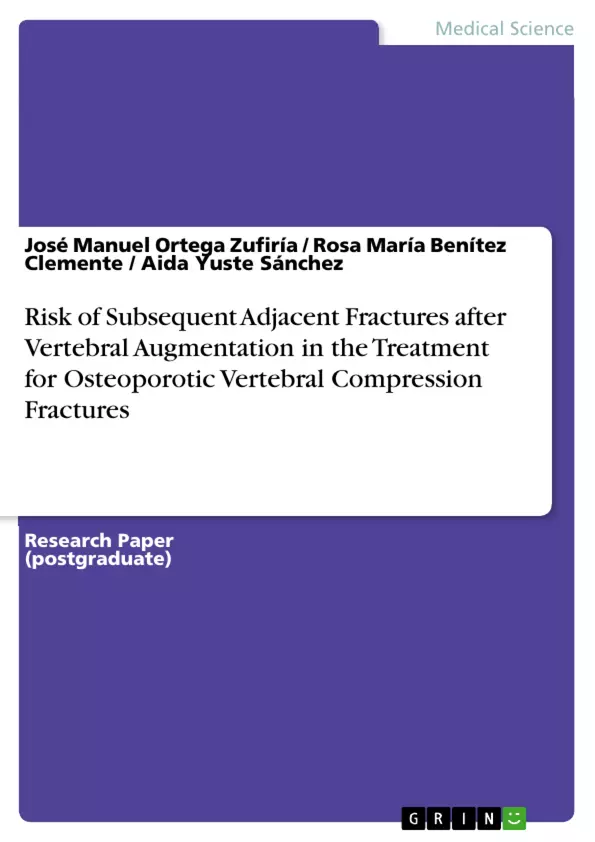The aim of this study was to investigate whether percutaneous vertebral augmentation (PVA) was associated with clinical and radiological subsequent adjacent fractures.
A systematic review and meta-analysis was performed searching on PubMed, EMBASE, Cochrane library, Google Scholar, web of science and ClinicalTrial.gov from the establishment of the database to January 2020. Eligible studies assessing the subsequent adjacent fractures after PVA compared with conservative treatment (CT) were incorporated. The pooled risk ratio (RR) with its 95% confidence intervals (95% CI) was used. Heterogeneity, sensitivity and publication bias analyses were performed.
A total of 24 studies were considered eligible and were included finally. 20/421 patients (4.75%) had clinical subsequent adjacent fractures from PVA group, and 25/359 patients (6.96%) had from CT group, and 46/440 patients (10.45%) from PVA group and 36/444 patients (8.10%) from CT group had radiological subsequent adjacent fractures. There both had no significant difference between two groups (RR=0.67, 95%CI: [0.38, 1.19], P = 0.17)/ (RR=1.13, 95%CI: [0.75, 1.70], P = 0.576). However, in fractured vertebrae, number in PVA group was more than that in CT group (RR=1.41, 95%CI: [1.03, 1.93], P = 0.03).
Collectively, currently available literature provides data showed PVA did not increase the incidence for subsequent adjacent fractures, no matter it was clinical or radiological fracture. But PVA may increase the number of fractured vertebrae.
Inhaltsverzeichnis (Table of Contents)
- ABSTRACT
- INTRODUCTION
- PATIENTS AND METHODS
- RESULTS
- DISCUSSIONS
- CONCLUSION
- REFERENCES
Zielsetzung und Themenschwerpunkte (Objectives and Key Themes)
This systematic review and meta-analysis aims to evaluate the association between percutaneous vertebral augmentation (PVA) and subsequent adjacent fractures, both clinical and radiological, in patients with osteoporotic vertebral compression fractures (OVCFs). The study also investigates whether PVA influences the number of fractured vertebrae.
- Effectiveness and safety of PVA in treating OVCFs
- Incidence of subsequent adjacent fractures after PVA
- Comparison of PVA to conservative treatment (CT)
- Distinguishing between clinical and radiological fractures
- Impact of PVA on the number of fractured vertebrae
Zusammenfassung der Kapitel (Chapter Summaries)
- ABSTRACT: This chapter provides a concise overview of the study's objectives, methods, results, and conclusions. It highlights the aim of investigating the association between PVA and subsequent adjacent fractures, both clinical and radiological, and the findings regarding the influence of PVA on the number of fractured vertebrae.
- INTRODUCTION: This chapter discusses the prevalence and impact of OVCFs, emphasizing the importance of effective treatment options. It introduces PVA as a minimally invasive therapy for OVCFs and outlines the potential complications, including subsequent fractures. It further highlights the need for comprehensive studies to evaluate the efficacy and safety of PVA.
- PATIENTS AND METHODS: This section details the systematic review and meta-analysis methodology employed in the study. It describes the database search strategy, inclusion criteria for eligible studies, and the data analysis methods used to assess the risk of subsequent adjacent fractures.
- RESULTS: This section presents the findings of the meta-analysis, including the pooled risk ratio (RR) for subsequent adjacent fractures and the number of fractured vertebrae in both PVA and CT groups. It also addresses the heterogeneity, sensitivity, and publication bias analyses performed.
- DISCUSSIONS: This section provides a detailed interpretation of the study's findings, discussing the implications of the results in the context of clinical practice and future research directions. It may also address limitations of the study and potential areas for further investigation.
Schlüsselwörter (Keywords)
This study focuses on percutaneous vertebral augmentation (PVA), osteoporotic vertebral compression fractures (OVCFs), subsequent adjacent fractures, clinical and radiological fracture, conservative treatment, systematic review, and meta-analysis. These terms encompass the primary research focus, important themes, and core concepts investigated in this work.
- Citation du texte
- José Manuel Ortega Zufiría (Auteur), Rosa María Benítez Clemente (Auteur), Aida Yuste Sánchez (Auteur), 2020, Risk of Subsequent Adjacent Fractures after Vertebral Augmentation in the Treatment for Osteoporotic Vertebral Compression Fractures, Munich, GRIN Verlag, https://www.grin.com/document/948546



